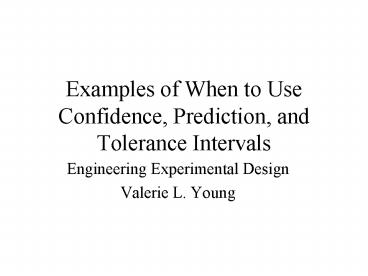Examples of When to Use Confidence, Prediction, and Tolerance Intervals - PowerPoint PPT Presentation
1 / 11
Title:
Examples of When to Use Confidence, Prediction, and Tolerance Intervals
Description:
Examples of When to Use Confidence, Prediction, and Tolerance Intervals ... n = 56 and p = 0.90, so tol critical = 1.6585 (Table B.12 in text; use the value ... – PowerPoint PPT presentation
Number of Views:53
Avg rating:3.0/5.0
Title: Examples of When to Use Confidence, Prediction, and Tolerance Intervals
1
Examples of When to Use Confidence, Prediction,
and Tolerance Intervals
- Engineering Experimental Design
- Valerie L. Young
2
When Do I Do What?
3
When Do I Do What?
4
Example 1
- You measure the zinc concentration in the livers
of 56 fish and find that the mean of these 56
values is 9.15 ?g Zn / g liver and the standard
deviation is 1.27 ?g Zn / g liver. What is the
concentration of zinc in fish liver? - n 56, so this is a large sample and we can use
z - For 95 confidence, we want 5 of the area in
the 2 tails, or 2.5 of the area in each - 1 0.025 0.975
- z(area 0.975) 1.96
- CI 1.96 ? 1.27 / sqrt(56) 0.3326
- Zinc concentration is 9.2 0.3 ?g Zn / g liver
(95 confidence interval) - Note if you use t-critical(?55) then you get
t-critical2.000 and CI 0.3394. No important
difference.
Based on a problem in Devore Farnum, Applied
Statistics for Engineers Scientists, 1999
5
Example 2
- You measure the zinc concentration in the livers
of 56 fish and find that the mean of these 56
values is 9.15 ?g Zn / g liver and the standard
deviation is 1.27 ?g Zn / g liver. What
concentration of zinc do you expect to find in
the next fish liver you eat? - n 56, so we need t-critical for ?60 (closest
we can get to 55) and ? 0.025 (half of 0.05). - t-critical 2.000 (Table B2 in text)
- PI 2.000 ? 1.27 ? sqrt(1(1/56)) 2.562
- Concentration of zinc in next fish will be 9.2
2.5 ?g Zn / g liver (95 prediction interval)
Based on a problem in Devore Farnum, Applied
Statistics for Engineers Scientists, 1999
6
Example 3
- You measure the zinc concentration in the livers
of 56 fish and find that the mean of these 56
values is 9.15 ?g Zn / g liver and the standard
deviation is 1.27 ?g Zn / g liver. What range
of zinc concentrations will describe the livers
of 90 of this type of fish? - n 56 and p 0.90, so tol critical 1.6585
(Table B.12 in text use the value for n60) - TI 1.6585 ? 1.27 2.106
- 90 of these fish are likely to have 9.5 2.1
?g Zn / g liver in their livers (95 confidence
level)
Based on a problem in Devore Farnum, Applied
Statistics for Engineers Scientists, 1999
7
Example 4
- Measurements of stabilized viscosity were made on
five asphalt specimens, resulting in values of
2781, 2900, 3013, 2856, and 2888 cP. What is the
viscosity of the asphalt? - Mean 2887.60 cP, sample std dev 84.03 cP
- n5, so use t-critical for ?4 and ?0.025
- t-critical 2.776 (Table B2 in text)
- CI 2.776 ? 84.03 / sqrt(5) 104
- The viscosity of the asphalt is 2890 100 cP
(95 confidence interval)
Based on a problem in Devore Farnum, Applied
Statistics for Engineers Scientists, 1999
8
Example 5
- Measurements of stabilized viscosity were made on
five asphalt specimens, resulting in values of
2781, 2900, 3013, 2856, and 2888 cP. If you
measured a sixth specimen, what would you expect
its viscosity to be? - Mean 2887.60 cP, sample std dev 84.03 cP
- n5, so use t-critical for ?4 and ?0.025
- T-critical 2.776 (Table B2 in text)
- PI 2.776 ? 84.03 ? sqrt(1 1/5) 256 cP
- The viscosity of the next asphalt will be 2890
260 cP (95 prediction interval)
Based on a problem in Devore Farnum, Applied
Statistics for Engineers Scientists, 1999
9
Example 6
- Measurements of stabilized viscosity were made on
five asphalt specimens, resulting in values of
2781, 2900, 3013, 2856, and 2888 cP. Give the
range of viscosities within which you would
expect 75 of specimens from this manufacturer
to lie. - Mean 2887.60 cP, sample std dev 84.03 cP
- n5. This sample is not large enough to derive a
tolerance interval. At least one more specimen
must be tested.
Based on a problem in Devore Farnum, Applied
Statistics for Engineers Scientists, 1999
10
Example 7
- You find that the 50 Duralife batteries last an
average of 4.15 hours (standard deviation 0.92
hours). You find that the 45 Rayolife batteries
last an average of 0.84 hours (standard deviation
1.64 hours). How much longer do Rayolife
batteries last? - The difference between the means is 0.38.
- 95 CI for the difference is 1.96 ?
sqrt((0.922/50)(0.842/45)) 0.3539 - Rayolife batteries last 0.38 0.35 hours longer
than duralife batteries (95 confidence level).
Based on a problem in Devore Farnum, Applied
Statistics for Engineers Scientists, 1999
11
Example 8
- Youre on a budget, so you purchase 10 Duralife
batteries and 10 Rayolife batteries. You find
that the Duralife batteries last an average of
4.15 hours (standard deviation 0.92 hours). You
find that the Rayolife batteries last an average
of 4.53 hours (standard deviation 0.84 hours).
How much longer do Rayolife batteries last? - CI 2.262 ? sqrt((0.922/10)(0.842/10)) 0.891
hours - Based on samples of 10, the difference in
lifetime between the battery brands is not
significant at the 95 confidence level. - Note that if the sample sizes are not the same,
there is a complex formula that must be used to
calculate the degrees of freedom.
Based on a problem in Devore Farnum, Applied
Statistics for Engineers Scientists, 1999

